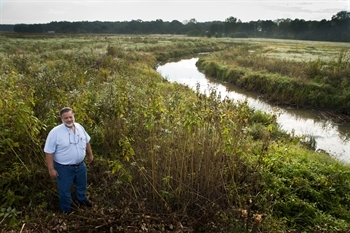
Thanks for subscribing to the What Our Water's Worth (WOWW) e-newsletter, part of a multimedia public awareness campaign, led by the Metropolitan Planning Council and Openlands, to raise awareness about the value of water in our region. Subscribe to our blog, visit our web site www.chicagolandh2o.org, "like" us on Facebook, and get in touch with us at info@chicagolandh2o.org to learn more about regional water issues. We also invite you to share your own stories, ideas and information that illustrate the value of water in your daily life.
Restoring wetlands, preserving our water supply

Ever since his childhood days visiting his grandparents in rural Wisconsin, Joe Roth has been a dedicated water steward. Growing up in an industrial neighborhood in Chicago, Joe relished escaping the city to spend time outdoors in open spaces, rivers, and streams – and those early experiences cultivated a profound appreciation for water. Today, Joe lives in Will County, and he has been preserving wetlands for 18 years.
“Water is everything,” says Joe. “It’s fundamental to sustaining our growing population, our economy, and the ecosystems we rely upon.”
Joe would know. As the director of restoration programs and special funds at Openlands, a regional conservation organization, he manages a 200-acre wetlands restoration project at the Hadley Valley Preserve in the Forest Preserve District of Will County. From an upland lookout point, we scan the panoramic view of the 650-acre preserve and beyond to rooftops of Joliet, population 152,000 – most of whom probably don’t realize that the rain running off their driveways and sidewalks quickly becomes the same water for many of they and their neighbors’ everyday needs, such as brushing their teeth and taking a shower.
Read on to learn more about Joe, the Hadley Valley Preserve, and how wetlands play a role in our drinking water.
Conservation tips
- Let it sink in. Reduce the amount of impervious surfaces such as asphalt and concrete driveways and sidewalks by using permeable pavers on your property instead.
- Plant native plants. Most prairie and wetland plants, as well as native wildflowers, have deep root systems that absorb water and reduce stormwater runoff.
- Wash wisely. You’ll use about 40% less water if you launder your clothes in a high-efficiency washer.
December 2010
www.chicagolandh2o.org
Upcoming events
| Dec 16 | MPC and Openlands Roundtable Right as Rain: Advancing Safe, Sustainable Water Reuse 12:00 PM–1:30 PM |
|---|
What Our Water’s Worth is an ongoing campaign led by the Metropolitan Planning Council and Openlands to raise awareness about the value of water in northeastern Illinois and northwestern Indiana. From Lake Michigan to the Fox River, how we use our water resources — including what we conserve, how much we waste, and what we choose to invest in water quality — is up to each of us. This is our water — and it's worth more than we know.
WOWW factors
90% wetlands lost
Illinois has lost all but 10% of its original wetlands acreage due to development.
49th
Illinois ranks second-to-last in the nation in percentage of native vegetation remaining.
9 to 10%
Percentage of Illinois' total population that relies on shallow aquifers as their water source.
407%
Increase in chloride concentration in Will County shallow groundwater, from 1950 to 2005. Road salt and stormwater runoff are major sources of salt contamination, which includes chloride.
What Our Water's Worth is a monthly e-newsletter. Tell us what you think. Email info@chicagolandh2o.org with feedback in the subject.
To subscribe, visit our website at chicagolandh2o.org.
To stop receiving this newsletter visit metroplanning.org/unsubscribe.html?
EmailMsgId=104
&email=

|
Metropolitan Planning Council
140 S Dearborn St | Suite 1400 | Chicago, IL 60603 Phone (312) 922-5616 phone | Fax (312) 922-5619 |
Openlands
25 E. Washington St. | Suite 1650 | Chicago, IL 60602 Phone: 312-863-6250 | Fax 312-427-6251 |
Copyright © 2025. All rights reserved. | info@chicagolandh2o.org
To stop receiving this newsletter visit metroplanning.org/unsubscribe.html?EmailMsgId=104&email=
